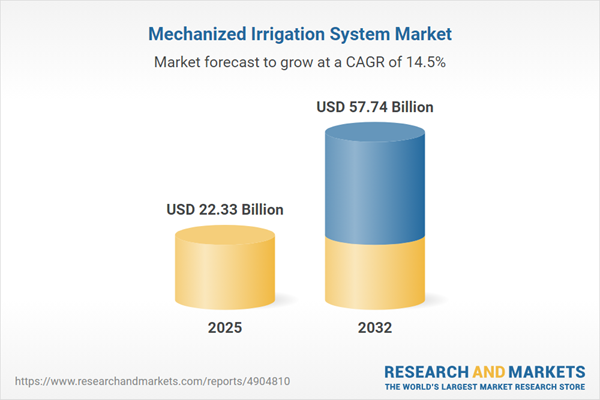Speak directly to the analyst to clarify any post sales queries you may have.
The mechanized irrigation system market is transforming water management for agricultural enterprises, offering smarter, data-driven control to address operational efficiency, regulatory standards, and sustainability goals. Senior decision-makers are leveraging automation and innovative technologies to achieve more resilient and compliant irrigation strategies across diverse industry applications.
Market Snapshot: Mechanized Irrigation System Market Growth Overview
The mechanized irrigation system market is experiencing robust expansion, with market value rising from USD 19.51 billion in 2024 to USD 22.33 billion in 2025, and a CAGR of 14.52% set to drive the market toward USD 57.74 billion by 2032. This growth is supported by a surge in digital agriculture adoption, compliance with strict sustainability standards, and rising demand for resource optimization. Notably, regional investments are accelerating the adoption of automation and advanced control, as organizations adapt to increasingly complex operational landscapes and regulatory requirements.
Scope & Segmentation
This report provides senior leaders with actionable insight into the primary segments guiding the mechanized irrigation system market, supporting informed strategy and risk mitigation:
- Irrigation Types: Center pivot, drip, lateral move, sprinkler, and subsurface drip irrigation methods—selected based on specific crop requirements, land topography, and climate adaptation needs.
- Applications: Covers agricultural fields, greenhouses, horticultural sites, and landscaping operations, each benefiting from increased water efficiency and enhanced productivity outcomes.
- Control Technologies: Encompasses automatic, manual, and semi-automatic systems, including Internet of Things-enabled, sensor-integrated, and timer-based controls for improved precision and real-time water application.
- Components: Considers key infrastructure such as controllers, filters, pipes, pumps, and valves, allowing organizations to evaluate system durability, scalability, and integration within existing operations.
- Distribution Channels: Compares the effectiveness of in-person dealers and service providers with the agility of online and digital procurement channels to strengthen supply chains.
- Regional Scope: Examines opportunities and regulatory developments in the Americas, Europe, Middle East, Africa, and Asia-Pacific, to inform international expansion and localization efforts.
- Leading Companies: Features company profiles and market positioning analysis for Netafim Ltd., Lindsay Corporation, Valmont Industries, The Toro Company, Rain Bird Corporation, Jain Irrigation Systems, Rivulis Irrigation, Reinke Manufacturing, Hunter Industries, and Irritec S.p.A., highlighting collaborative and technology-driven leadership trends.
Key Takeaways for Senior Decision-Makers
- Integrating automated and real-time data platforms is redefining traditional irrigation, resulting in more responsive and resource-efficient operations that enable agile decision-making for large-scale agricultural businesses.
- Procurement strategies must now incorporate compliance-driven criteria, as sustainability and regulatory factors take precedence across procurement lifecycles and operational jurisdictions.
- Collaborative innovation—combining established manufacturers, tech disruptors, and research institutions—is advancing the market’s technological frontiers and opening pathways for differentiated smart solutions.
- Organizations enhancing supply chain resilience through regional manufacturing, diversification, and increased localization are better positioned to sustain uninterrupted service amidst geopolitical and tariff fluctuations.
- Implementing circular economy principles such as component refurbishment and reuse supports cost management and strengthens environmental stewardship, aligning with the evolving expectations of international markets.
- Expanding digital distribution channels increases market accessibility for vendors and accelerates onboarding processes for B2B clients, fostering a more agile and scalable commercial environment.
Tariff Impact: Strategic Responses to 2025 U.S. Tariffs
New U.S. tariffs introduced in 2025 are prompting manufacturers to adapt supply strategies by prioritizing alternative sourcing and expanding domestic production. Innovative changes in component design are helping firms control costs and maintain operational flexibility. Distributors respond with updated contracts and dynamic pricing, while many organizations increase their vertical integration and localization to safeguard margins and assure stable delivery in unpredictable markets.
Methodology & Data Sources
This research draws from primary interviews with system integrators, industry experts, and equipment manufacturers. Findings are further validated through analysis of secondary sources, including white papers and peer-reviewed publications. The methodology includes multi-stage verification via stakeholder workshops, expert panels, and patent analysis to ensure consistent and reliable data.
Why This Report Matters
- Provides a robust framework for integrating digital and sustainable irrigation technologies, helping organizations enhance operational efficiency and maintain compliance with evolving agricultural regulations.
- Supports supply chain and procurement leaders by identifying key market risks, streamlining sourcing decisions, and presenting actionable recommendations for new market opportunities.
- Equips senior executives with the intelligence to enhance competitive positioning and implement resilience strategies that align with regulatory and technological change.
Conclusion
Rapid technology advances and shifting business demands are shaping the mechanized irrigation system market. Investment in innovation and adaptive strategies positions organizations to lead sustainable agriculture and respond confidently to global challenges.
Additional Product Information:
- Purchase of this report includes 1 year online access with quarterly updates.
- This report can be updated on request. Please contact our Customer Experience team using the Ask a Question widget on our website.
Table of Contents
3. Executive Summary
4. Market Overview
7. Cumulative Impact of Artificial Intelligence 2025
List of Figures
Samples

LOADING...
Companies Mentioned
The key companies profiled in this Mechanized Irrigation System market report include:- Netafim Ltd.
- Lindsay Corporation
- Valmont Industries, Inc.
- The Toro Company
- Rain Bird Corporation
- Jain Irrigation Systems Limited
- Rivulis Irrigation Ltd.
- Reinke Manufacturing Co., Inc.
- Hunter Industries Inc.
- Irritec S.p.A.
Table Information
| Report Attribute | Details |
|---|---|
| No. of Pages | 186 |
| Published | October 2025 |
| Forecast Period | 2025 - 2032 |
| Estimated Market Value ( USD | $ 22.33 Billion |
| Forecasted Market Value ( USD | $ 57.74 Billion |
| Compound Annual Growth Rate | 14.5% |
| Regions Covered | Global |
| No. of Companies Mentioned | 11 |









